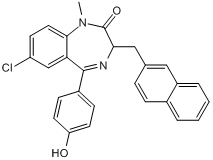| Reference | 1. Biochem Pharmacol. 2009 Oct 15;78(8):966-73. doi: 10.1016/j.bcp.2009.05.025. Epub
2009 May 27.
<br>
Bz-423 superoxide signals B cell apoptosis via Mcl-1, Bak, and Bax.
<br>
Blatt NB(1), Boitano AE, Lyssiotis CA, Opipari AW Jr, Glick GD.
<br>
Author information: <br>
(1)Department of Pediatrics and Communicable Diseases, University of Michigan,
F6865 Mott SPC 5297, 1500 E. Medical Center Drive, Ann Arbor, MI 48109-5297,
United States. [email protected]
<br>
Bz-423 is a pro-apoptotic 1,4-benzodiazepine with therapeutic properties in
murine models of lupus demonstrating selectivity for autoreactive lymphocytes.
Bz-423 modulates the F(1)F(0)-ATPase, inducing the formation of superoxide within
the mitochondrial respiratory chain, which then functions as a second messenger
initiating apoptosis. In order to understand some of the features that contribute
to the increased sensitivity of lymphocytes, we report the signaling pathway
engaged by Bz-423 in a Burkitt lymphoma cell line (Ramos). Following the
generation of superoxide, Bz-423-induced apoptosis requires the activation of Bax
and Bak to induce mitochondrial outer membrane permeabilization and cytochrome c
release. Knockdown of the BH3-only proteins Bad, Bim, Bik, and Puma inhibits
Bz-423 apoptosis, suggesting that these proteins serve as upstream sensors of the
oxidant stress induced by Bz-423. Treatment with Bz-423 results in
superoxide-dependent Mcl-1 degradation, implicating this protein as the link
between Bz-423-induced superoxide and Bax and Bak activation. In contrast to
fibroblasts, B cell death induced by Bz-423 is independent of c-Jun N-terminal
kinase. These results demonstrate that superoxide generated from the
mitochondrial respiratory chain as a consequence of a respiratory transition can
signal a specific apoptotic response that differs across cell types.
<br>
2. Free Radic Biol Med. 2008 Nov 1;45(9):1232-42. doi:
10.1016/j.freeradbiomed.2008.07.022. Epub 2008 Aug 3.
<br>
Bz-423 superoxide signals apoptosis via selective activation of JNK, Bak, and
Bax.
<br>
Blatt NB(1), Boitano AE, Lyssiotis CA, Opipari AW Jr, Glick GD.
<br>
Author information: <br>
(1)Department of Pediatrics, University of Michigan, Ann Arbor, MI 48109, USA.
<br>
Bz-423 is a proapoptotic 1,4-benzodiazepine with potent therapeutic properties in
murine models of lupus and psoriasis. Bz-423 modulates the F(1)F(0)-ATPase,
inducing the formation of superoxide within the mitochondrial respiratory chain,
which then functions as a second messenger initiating apoptosis. Herein, we
report the signaling pathway activated by Bz-423 in mouse embryonic fibroblasts
containing knockouts of key apoptotic proteins. Bz-423-induced superoxide
activates cytosolic ASK1 and its release from thioredoxin. A mitogen-activated
protein kinase cascade follows, leading to the specific phosphorylation of JNK.
JNK signals activation of Bax and Bak which then induces mitochondrial outer
membrane permeabilization to cause the release of cytochrome c and a commitment
to apoptosis. The response of these cells to Bz-423 is critically dependent on
both superoxide and JNK activation as antioxidants and the JNK inhibitor SP600125
prevents Bax translocation, cytochrome c release, and cell death. These results
demonstrate that superoxide generated from the mitochondrial respiratory chain as
a consequence of a respiratory transition can signal a sequential and specific
apoptotic response. Collectively, these data suggest that the selectivity of
Bz-423 observed in vivo results from cell-type specific differences in redox
balance and signaling by ASK1 and Bcl-2 proteins.
<br>
3. Chem Biol. 2005 Apr;12(4):485-96.
<br>
Identification and validation of the mitochondrial F1F0-ATPase as the molecular
target of the immunomodulatory benzodiazepine Bz-423.
<br>
Johnson KM(1), Chen X, Boitano A, Swenson L, Opipari AW Jr, Glick GD.
<br>
Author information: <br>
(1)Department of Chemistry, University of Michigan, Ann Arbor, Michigan 48109,
USA.
<br>
Comment in<br>
Chem Biol. 2005 Apr;12(4):414-5.
<br>
Bz-423 is a 1,4-benzodiazepine that suppresses disease in lupus-prone mice by
selectively killing pathogenic lymphocytes, and it is less toxic compared to
current lupus drugs. Cells exposed to Bz-423 rapidly generate O(2)(-) within
mitochondria, and this reactive oxygen species is the signal initiating
apoptosis. Phage display screening revealed that Bz-423 binds to the oligomycin
sensitivity conferring protein (OSCP) component of the mitochondrial
F(1)F(0)-ATPase. Bz-423 inhibited the F(1)F(0)-ATPase in vitro, and
reconstitution experiments demonstrated that inhibition was mediated by the OSCP.
This target was further validated by generating cells with reduced OSCP
expression using RNA interference and studying the sensitivity of these cells to
Bz-423. Our findings help explain the efficacy and selectivity of Bz-423 for
autoimmune lymphocytes and highlight the OSCP as a target to guide the
development of novel lupus therapeutics.
<br>
|

